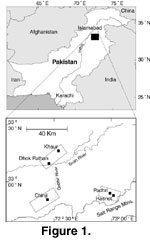MATERIALS AND METHODS
 This
study is based on 1,579 fossil snake specimens from 139 localities on the Potwar
Plateau of north-central Pakistan (Figure 1), spanning a temporal range of
approximately 18 to 6 Ma (e.g.,
Badgley and Behrensmeyer 1995, and
references therein). This dataset is the result of intensive, systematic
surface-collection and screen-washing of over 1,000 fossil localities through
collaborative fieldwork by representatives of the Geological Survey of Pakistan
and multiple institutions from the United States, including Yale University,
Harvard University, the University of Arizona, the University of Michigan,
Dartmouth College, the Smithsonian Institution, University of Illinois at
Chicago, and Southern Methodist University. Screen-washing efforts have been led
by E.H. Lindsay and students, and especially by W.R. Downs III. Additionally,
the record examined by Hoffstetter (1964) and housed in the Bayerische
Staatssammlung für Paläontologie und historische Geologie, Munich was examined.
This
study is based on 1,579 fossil snake specimens from 139 localities on the Potwar
Plateau of north-central Pakistan (Figure 1), spanning a temporal range of
approximately 18 to 6 Ma (e.g.,
Badgley and Behrensmeyer 1995, and
references therein). This dataset is the result of intensive, systematic
surface-collection and screen-washing of over 1,000 fossil localities through
collaborative fieldwork by representatives of the Geological Survey of Pakistan
and multiple institutions from the United States, including Yale University,
Harvard University, the University of Arizona, the University of Michigan,
Dartmouth College, the Smithsonian Institution, University of Illinois at
Chicago, and Southern Methodist University. Screen-washing efforts have been led
by E.H. Lindsay and students, and especially by W.R. Downs III. Additionally,
the record examined by Hoffstetter (1964) and housed in the Bayerische
Staatssammlung für Paläontologie und historische Geologie, Munich was examined.
Methods used for systematic identifications in this study differ from the
majority of analyses of fossil snakes using vertebral morphology. It is common
in most studies for general morphological similarity and geographic and temporal
parsimony to be invoked in taxonomic assignments of snake vertebrae. However,
these methods make implicit assumptions about relationships between extant and
fossil faunas, and introduce circularity in biogeographic reconstructions (Bell
et al. 2004). This study bases systematic hypotheses on apomorphic characters.
As a result, for several taxa in this study, morphotypic, as opposed to
taxonomic, assignments are used, based on characters that are taxonomically
ambiguous, but consistently subdivide the Siwalik Group sample. Consequently,
this study minimizes taxonomic and systematic claims relative to other analyses
(e.g., Szyndlar 1984;
Parmley and Holman 1995), limiting the ability to make
comparisons of diversity and species richness. Finally, it should be noted that
vertebral morphology for the vast majority of snake species remains undescribed.
Consequently, diagnostic characters used to erect the three new colubroids
described here may instead be characteristic of extant species. Therefore,
systematic assignments may change dramatically when vertebral morphology of
snakes is better documented.
Anatomical terminology follows
Rage (1984) and
Holman (2000), unless
specifically cited, and Figure 2 labels anatomy unique to snakes.
Institutional Abbreviations
BMNH, Natural History Museum, London;
BSP, Bayerische Staatssammlung für Paläontologie und historische Geologie,
Munich. DP, Dartmouth College–Peshawar University, H-GSP,
Harvard-Geological Survey of Pakistan; Y, Yale University.
Stratigraphic abbreviation
KL,
Khaur level

 This
study is based on 1,579 fossil snake specimens from 139 localities on the Potwar
Plateau of north-central Pakistan (Figure 1), spanning a temporal range of
approximately 18 to 6 Ma (e.g.,
Badgley and Behrensmeyer 1995, and
references therein). This dataset is the result of intensive, systematic
surface-collection and screen-washing of over 1,000 fossil localities through
collaborative fieldwork by representatives of the Geological Survey of Pakistan
and multiple institutions from the United States, including Yale University,
Harvard University, the University of Arizona, the University of Michigan,
Dartmouth College, the Smithsonian Institution, University of Illinois at
Chicago, and Southern Methodist University. Screen-washing efforts have been led
by E.H. Lindsay and students, and especially by W.R. Downs III. Additionally,
the record examined by Hoffstetter (1964) and housed in the Bayerische
Staatssammlung für Paläontologie und historische Geologie, Munich was examined.
This
study is based on 1,579 fossil snake specimens from 139 localities on the Potwar
Plateau of north-central Pakistan (Figure 1), spanning a temporal range of
approximately 18 to 6 Ma (e.g.,
Badgley and Behrensmeyer 1995, and
references therein). This dataset is the result of intensive, systematic
surface-collection and screen-washing of over 1,000 fossil localities through
collaborative fieldwork by representatives of the Geological Survey of Pakistan
and multiple institutions from the United States, including Yale University,
Harvard University, the University of Arizona, the University of Michigan,
Dartmouth College, the Smithsonian Institution, University of Illinois at
Chicago, and Southern Methodist University. Screen-washing efforts have been led
by E.H. Lindsay and students, and especially by W.R. Downs III. Additionally,
the record examined by Hoffstetter (1964) and housed in the Bayerische
Staatssammlung für Paläontologie und historische Geologie, Munich was examined.